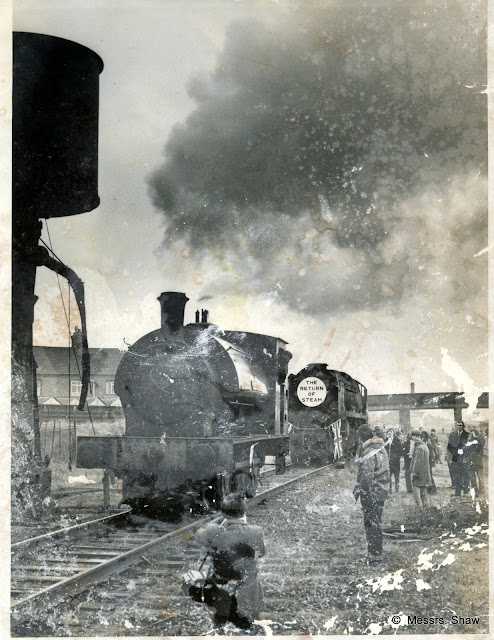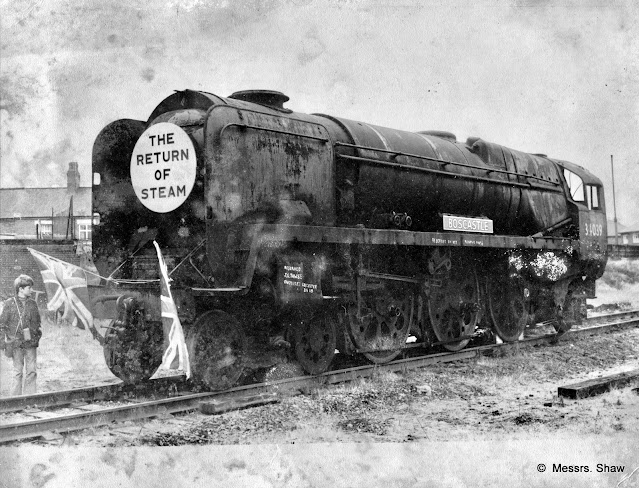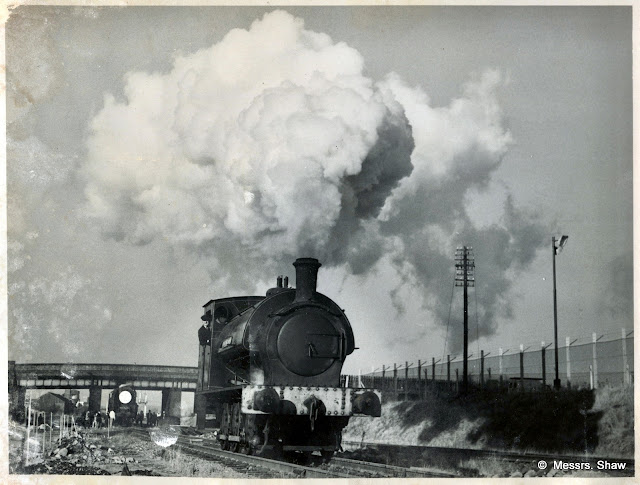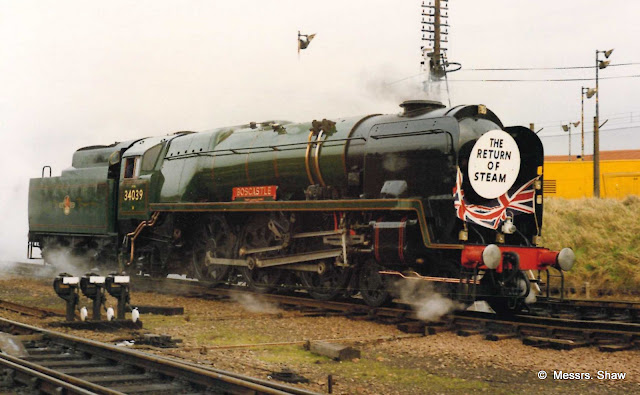Here's another fascinating guest post for the blog's 10th anniversary!
I've known Nick for a while now - we often seem to be at the same heritage event, or in the same heritage meeting - but I have no idea of actually how long we've known each other! Anyway, I am pleased to be able to share with you Nick's guest post on my blog, in which we hear about his memories of visiting Loughborough's Great Central Railway with his father, and especially their encounter with 34039, aka 'Boscastle'! What a lot of work goes on behind the scenes at the GCR, so visitors can enjoy a great day out!
The Great Central Railway through Loughborough:
some personal thoughts and connections
Nick Shaw
There’s much talk at the moment about the billions being spent on HS2 to improve rail links between London, the Midlands and the ‘Northern Powerhouse’. A high-speed rail link is apparently needed to bring Britain’s largest economic regions (London, the Midlands and North-West) together.
Yet turn the clocks back 130-or-so years and exactly that was proposed by Edward Watkin, an ambitious industrialist and chairman of the Manchester, Sheffield and Lincolnshire Railway [1]. Having already achieved a network of railways to connect the North West with the coalfields of Nottinghamshire, Watkin had a grand plan to extend his railway not only to London, but also to continental Europe via a Channel Tunnel.
Construction of his ‘London Extension’ started in 1894 and in 1899 the Great Central Railway opened with Marylebone as its magnificent London terminus. To fulfill the aim of being a high-speed link the line was built to a continental loading gauge (ready to accommodate trains to and from Europe), no sharp curves, no steep gradients, and no level crossings. It was the original HS2 - albeit 130 years early.
The Great Central was subsequently amalgamated into the LNER and, post-nationalisation, into the Eastern Region of British Railways. The 1950s saw the growth of vehicle movements by road and the GCR was run-down as services were transferred to the Midland line.
In 1963 the smaller country stations such as Rothley and Quorn & Woodhouse were closed, but the Beeching Report of the same year saw the death knell of the line. On 3rd May 1969, the last train departed from Loughborough Central and the line closed.
In some ways it was an opportunity missed, as the line had other features which contributed to it being a fast and safe railway. For example, take a visit to the current Loughborough (Midland) Station and you’ll see that the platforms are built each side of the tracks, necessitating buildings such as waiting rooms having to be built on both sides, as well as attendant dangers of having to cross the running lines.
The Great Central had a different plan. Rather than building the platforms around the tracks, at the smaller stations they built the tracks around the platform, meaning only one set of buildings was required and there were no issues in crossing the tracks. Our local stations at Loughborough Central, Quorn, Rothley and the now-demolished Belgrave and Birstall were all built to this genius pattern. No wonder the motto of the GCR was ‘Forward’.
On that final day in 1969, my father climbed a few steps up the water tower at the end of the platform at Loughborough Central to photograph the last train departure, with a young 8-year-old in shorts looking on [2]. That 8-year-old was me – and thus started a now 54-year interest in the fortunes of the resurgent Great Central Railway.
 |
| The last train leaving Loughborough Central before closure May 1969, Nick in shorts looking on! |
As that last train pulled out of Loughborough, a group of enthusiasts were forming the Main Line Preservation Group with the aim of restoring and preserving the Leicester to Nottingham section, with Loughborough Central as its base.
The group set about the early stages of restoring the station and then in January 1973 staged its first operating day with one industrial steam locomotive giving demonstrations. My father and I were there to record that day too, and this year the GCR is proudly celebrating 50 years of operations, still looking ‘Forward’ to what they hope to achieve in the future.
 |
| January 1973, opening weekend at the GCR |
The first mainline locomotive to arrive at Loughborough was West Country Pacific 34039 ‘Boscastle’, in a totally unrestored state from Barry scrapyard. On display on that opening day in 1973, my father photographed the loco with yours truly inspecting the front buffers of the rusting hulk.
 |
| The unrestored Boscastle at the GCR opening weekend, January 1973, with a young Nick at the buffers |
 |
| Robert Nelson No.4 at the GCR in January 1973 |
The herculean task facing the groups and volunteers trying to restore these magnificent engines is that it takes hundreds of thousands of working hours to strip them down, clean and repair every part and then slowly put it all back together again. This process can take years, dependent on the resources and finances available.
Steam locomotives are very high maintenance. After all, they are basically a huge kettle where the boiler holds heated water to a pressure of 250psi, with all the attendant risks that brings. Following years of restoration, the locos are granted a 10-year certificate, at the end of which they have to be stripped down to the last nut and bolt for the whole process to start again.
The current GCR fleet of steam locos at Loughborough comprises 15 engines, of which at any one time around 5 or 6 are operational with the remainder going through that cycle of repair and restoration. You have to take your hat off to the committed volunteers in the loco shed who give so much time to keep the engines running.
In Boscastle’s case, it took nearly 30 years of painful hard work until the loco was launched into service in early 1992, yet just eight years later it had to be withdrawn pending another full overhaul.
 |
| Boscastle finally in steam at the GCR in January 1992 |
 |
| The Flying Scotsman leaving Loughborough's GCR late 1992 |
It’s sobering that in its 50-year sojourn at Loughborough, Boscastle has spent 42 years under restoration or repair. As part of the GCR’s 50-year anniversary, the partially restored Boscastle was wheeled out in June and I took the opportunity to recreate the photograph of me standing by the front buffers – with a little less hair these days.
 |
| A restored Boscastle pictured in June 2023, with Nick again at the buffers! |
Throughout the last 50 years the modern-day GCR has adopted the ‘Forward’ motif and pushed through with some big infrastructure projects, making it the only double-track heritage main line railway in the UK. Apart from casual visitors and enthusiasts, this also makes it a valuable testing centre for new locomotives and vehicles as the modern-day national railway continues to evolve. Special dispensation allows steam locos to run at up to 60mph and diesels to 75mph under strict conditions, but this can also be a valuable source of income for the line.
What it lacks at the moment is a rail connection to the national network, but the current project to re-unite the Loughborough to Leicester section with the Loughborough to Ruddington northern section [3] will see the creation of an 18-mile railway, including that all-important connection to the national network to bring in locomotives, charters and other vehicles without the need to transport them on a low loader.
This ‘Bridging the Gap’ project is well-advanced with a bridge already in place over the midland main line and the rusting A60 bridge next to the Brush works having been replaced last year [4].
When will it all be completed? Who knows, but it could well be within the next three or four years. In which case, which loco will pull the first train over the gap to reunite the two sections? I guess it could be any from the fleet, but I know that a good few people who have followed the GCR’s fortunes over the years will be hoping it’s 34039 Boscastle. And I hope to be there to witness it – and it will be before HS2 is finished.
____________________________________
Notes
[1] There is a society dedicated to Sir Edward William Watkin, called the WatSoc, where you can find lots of information about Sir Edward and the family. An entry for him also appears in 'A-Z of Loughborough', and there are numerous books written about him, for example, that by Canon John Neville Greaves, called 'Sir Edward Watkin 1819-1901: the last of the railway kings'
[2] The Platform
Water Tank and both the South and the North Water Tanks were added to the
Register of Listed Buildings, and assigned Grade II status in 2005.
[3] 'Bridging the Gap', i.e. the actual railway bridge that was installed in November 2017 is the final entry in 'Loughborough in 50 Buildings'. The whole project to link with Ruddington is now branded under the title 'Reunification', which has its own website.
[4] 'Bridging the Gap', i.e. the actual railway bridge that was installed in November 2017 is the final entry in 'Loughborough in 50 Buildings', and lynneaboutloughborough posted some photographs of the replacement of the bridge near Brush.
____________________________________
____________________________________
Posted by lynneaboutloughborough
With apologies for
typos which are all mine!
_______________________________________________
Thank you for reading this blog.
Copyright:
The copyright © of all content on this blog rests with me, or in the case of guest blogposts, with the named Guest Blogger. However, you are welcome to quote passages from any of my posts, with appropriate credit. The correct citation for this looks as follows:
Shaw, Nick (2023). The Great Central Railway through Loughborough: some personal thoughts and connections. Available from: https://lynneaboutloughborough.blogspot.com/2023/08/great-central-railway-through.html [Accessed 19 August 2023]
Take down
policy:
I post no pictures that are not my own, unless I have express permission so to do. All text is my own, and not copied from any other information sources, printed or electronic, unless identified and credited as such. If you find I have posted something in contravention of these statements, or if there are photographs of you which you would prefer not to be here, please contact me at the address listed on the About Me page, and I will remove these.
Blog
archive and tags:
If you are viewing this blog in mobile format, you will not be able to easily access the blog archive, or the clickable links to various topics. These can be accessed if you scroll to the bottom of the page, and click 'View Web Version'. Alternatively, there is also a complete list of posts, which when clicked will take you to the page you are interested in.
Searching
the blog:
You can search the blog using the dedicated search box that appears near the top of the blog when viewed in the web version. Alternatively, you can search using your usual search engine (e.g. Bing, Google, DuckDuckGo etc.) by following this example:
site: https://lynneaboutloughborough.blogspot.com/ “Radmoor House”
NOTE – the words you’re actually looking for must be in “” and the first of these must be preceded by a space
Thank you for reading this blog.
Lynne
No comments:
Post a Comment
If you have found this post interesting or have any questions about any of the information in it do please leave a comment below. In order to answer your question, I must publish your query here, and then respond to it here. If your information is private or sensitive, and you don't wish to have it on public display, it might be a better idea to email me using the address which is on the About Me page, using the usual substitutions: if you take the email route, our conversation remains private, and is not published on the blog. Thanks for reading the blog.